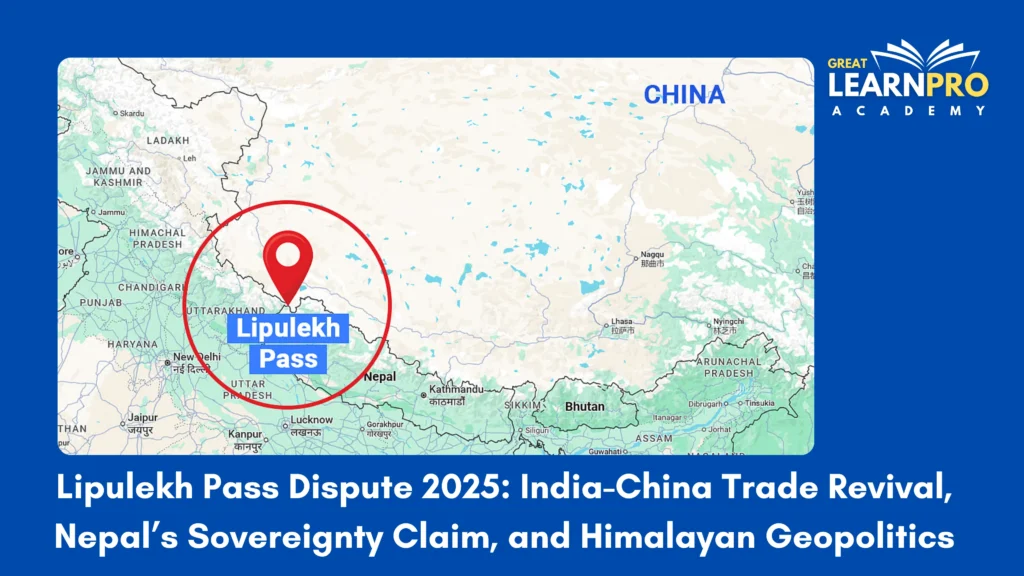
Rekindled Tensions at a Strategic Himalayan Crossroads
The Lipulekh Pass, nestled in the Himalayas at the India-Nepal-China tri-junction, has resurfaced as a diplomatic flashpoint. A territory of historical, religious, and geostrategic importance, the pass links India’s Uttarakhand with Tibet and serves as a vital route for the Kailash Mansarovar pilgrimage and cross-border trade, including the trade route to China from India. The region also falls under Nepalese claim as part of its Kalapani-Limpiyadhura-Lipulekh area.
India and China Rekindle Trade
In August 2025, India and China agreed to resume border trade through Lipulekh Pass, reviving a route that had remained inactive since the onset of the COVID-19 pandemic. Indian traders, particularly from the Rung community, have long sought this revival. They cite improved infrastructure—most notably, the completion of the Tawaghat-Lipulekh road in 2022—as a foundation to restart cross-border commerce that could boost local livelihoods.
Nepal’s Firm Objection
Nepal swiftly lodged formal diplomatic protests. On August 23, 2025, it sent diplomatic notes to both New Delhi and Beijing, reiterating its constitutional claim that Lipulekh, along with nearby areas, lies within Nepali territory east of the Mahakali River. The Kathmandu government views the India-China arrangement as unilateral and dismissive of its sovereign rights, especially given prior objections raised in 2015 when India and China first declared the pass a trade route without Nepal’s consent.
India’s Rejection and Call for Dialogue
India responded firmly. On August 20, 2025, the Ministry of External Affairs officially labeled Nepal’s claims as “unjustified,” “untenable,” and lacking historical basis. The MEA reiterated that trade via Lipulekh has existed since 1954 and was only halted due to pandemic-related disruptions. Alongside dismissing Nepal’s objections, India affirmed its openness to “constructive interaction” to resolve pending boundary issues through diplomacy.
Strategic Undercurrents and China’s Role
Lipulekh is not merely a border pass; it’s a strategic corridor for troop and logistics movement along India-China’s sensitive frontier. Its reopening signals a diplomatic thaw between Delhi and Beijing, even though China has maintained neutrality regarding the India-Nepal dispute. Moreover, China’s tacit acceptance—by engaging in the trade agreement reinforces India’s administrative claim and places Nepal in a more isolated diplomatic stance.
Local Voices Demand Action
Beyond high-level diplomacy, the saga resonates locally. Traders in Uttarakhand’s Dharchula area, dependent on trade through the pass, have urged an early resumption of commerce, tying the pass’s reopening directly to regional economic revival.
Historical Context and Treaty Interpretations
The roots of this dispute trace back to the 1816 Treaty of Sugauli, which earmarked the Kali River (Mahakali) as the boundary between Nepal and British India. The crux of contention lies in where that river actually originates. Nepal claims it begins in Limpiyadhura, implying that Lipulekh belongs to Nepal; India holds that the main river starts at the Kalapani springs, rendering the disputed region Indian territory. Nepal’s constitutional amendment in 2020, which incorporated Lipulekh into its official map, added legal weight to its claim but also intensified diplomatic friction.
What Lies Ahead?
With Prime Minister KP Sharma Oli’s diplomatic visits scheduled first to China for the Shanghai Cooperation Organisation summit and then to India Nepal faces mounting pressure to assert its stance on multiple fronts. Whether these visits will thaw tensions or conclude with more strain remains to be seen.
Despite the disagreements, India continues to emphasize diplomacy and dialogue. But for Nepal, the Lipulekh Pass is not just terrain—it embodies questions of national identity, sovereignty, and historical justice. Unresolved on the ground and in treaty interpretations, the Lipulekh issue remains emblematic of the delicate balance between geography, historic agreements, and geopolitics in the Himalayan crucible.
More Current Affairs: https://learnproacademy.in/updates/
